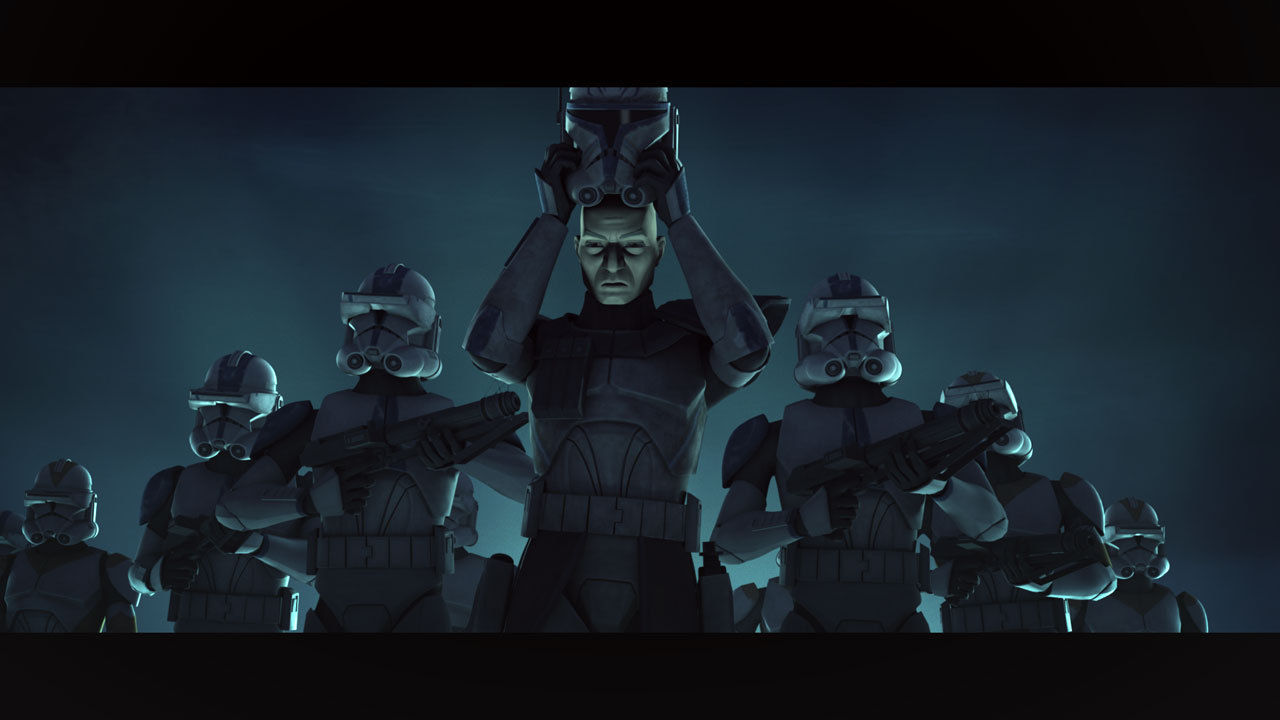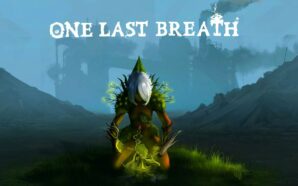With the glorious and unexpected return of Star Wars: The Clone Wars for a seventh and final season, over the past few months I’ve been rewatching the excellent animated series that fleshed out and radically improved the prequel era of storytelling. It’s taken me back to when I first watched the series a few years ago, after it had aired on television and ploughing through the series a Blu-ray disc at a time. While there’s enjoyment to be had from the start, the series really finds its feet midway through the third season with the arc beginning with the episode ‘Nightsisters’, and the final episode of that arc reintroduces Darth Maul back into the franchise after his apparent death in The Phantom Menace.
After that episode I desperately wanted to get to the next part of that storyline and seeing Maul feature prominently on the fourth season’s Blu-ray cover filled me with glee. I admit that I rushed through the fourth season to get to the continuation of that storyline, which is told over the final four episodes, and in that fervour I missed the true greatness of an earlier arc in the season. Upon this rewatch, taking it slow with knowledge of what is to come, I came to truly appreciate this arc and now see that the best episodes of The Clone Wars were the ones I once glossed over. The continuing Darth Maul and Mandalore arcs are excellent but the series actually hit its peak with the four-episode ‘Darkness on Umbara’ storyline.
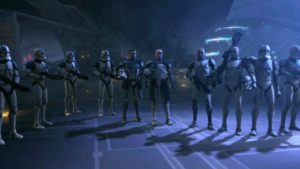 As the final season of the series is showing us, The Clone Wars – while dominated by well known characters like Anakin Skywalker and Obi-Wan Kenobi – is ultimately the story of Ahsoka Tano and the titular clone troopers. While we still have the much anticipated ‘Siege of Mandalore’ to come, Ahsoka’s storyline – since continued in Star Wars: Rebels – hit its peak with the season 5 finale, while the clones have never been explored better than the Umbara storyline.
As the final season of the series is showing us, The Clone Wars – while dominated by well known characters like Anakin Skywalker and Obi-Wan Kenobi – is ultimately the story of Ahsoka Tano and the titular clone troopers. While we still have the much anticipated ‘Siege of Mandalore’ to come, Ahsoka’s storyline – since continued in Star Wars: Rebels – hit its peak with the season 5 finale, while the clones have never been explored better than the Umbara storyline.
The arc sees the 501st legion invade the separatist world of Umbara, a dangerous planet under a shroud of perpetual darkness, in the hope of capturing the capital city from the native population. When General Skywalker is called back to Coruscant, the clones are left under the command of the notorious General Pong Krell. Krell sees the troopers as nothing but weapons, and disposable ones at that, refusing to see them as anything more than the purpose they were bred for. He endangers their lives with brutish tactics and soon the clones come to question their leader, his attitude and his motive. After ignoring Krell’s orders and creating their own elaborate plans to capture a vital airbase and destroy the droid fleet, the clones are court-martialled and set to be executed, leading them to their boldest course of action to date: treason.
One of the highlights of the series is the added depth and valuable insights we receive into the lives of clone troopers and the Umbara arc takes this to the next level. First of all, it feels like the Avengers Assemble of clones because troopers seen in episodes from across the three previous seasons all join forces for the invasion of Umbara. There’s Fives, Dogma, Tup, Hardcase, Kix, Jesse, Waxer and many more all under the command of the ever-reliable Captain Rex. It’s not just the clones themselves that these episodes coalescence either but their camaraderie built up over previous episodes, like the first season standout ‘Rookies’, pays off and the dynamic and relationships between the clones are deep and compelling.
One of the potential issues born from the mere concept of the series is how do you possibly tell a story with identical clones and have them come across as easily distinguishable individuals. The arc is a masterclass of just that and each clone has a distinct personality, such as Dogma being the young idealistic clone that remains loyal to Krell, and Fives, after everything he’s been through, being an early doubter of their new Jedi commander. Although, there was the odd occasion when I couldn’t tell who was who, despite the assortment of personalised armour and face tattoos. Brand me a racist but come on, they all do look alike.
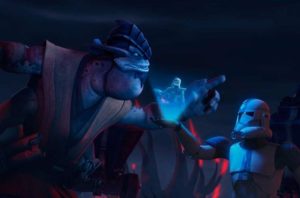 While we’ve grown attached to several of the clones over the course of the series, might pride ourselves on knowing their names and no longer see them as the disposable CGI soldiers the films presented them as, the series up to this point had danced around the big questions surrounding their nature. Krell in a way represents what a newcomer to the series might think: that clones are bred for no other reasons but to obey and fight and die. The Umbara arc counters this line of thinking, not just by showing us a variety of likable clones but by creating a story and a dialogue around the subject.
While we’ve grown attached to several of the clones over the course of the series, might pride ourselves on knowing their names and no longer see them as the disposable CGI soldiers the films presented them as, the series up to this point had danced around the big questions surrounding their nature. Krell in a way represents what a newcomer to the series might think: that clones are bred for no other reasons but to obey and fight and die. The Umbara arc counters this line of thinking, not just by showing us a variety of likable clones but by creating a story and a dialogue around the subject.
The arc sees the clones rebel and demand to be seen as people, unwilling to die just because a Jedi requested it of them. While the clones themselves discuss their nature among themselves (is Hardcase hyperactive because his growth acceleration tank sprung a leak or because that’s just his personality?) the episodes actually show us the true nature of the clones through their actions instead of just telling us. They have the ability to question orders unlike the programmed droids they fight. One of the most surprisingly painful aspects of the arc is Krell refusing to use the names the clones have given themselves and each other, instead sticking to their designation number, something that stings even more since seeing Finn in the sequel trilogy. The clones are similar yet distinct and the entire arc is an incredible showcase for actor Dee Bradley Baker who voices each and every one of the troopers brilliantly.
Re-watching this arc for the first time in a few years, after seeing some of the recent Disney-era films, brought to mind the battle for Mimban in Solo: A Star Wars Story. In that we see a ground war between an invasion force and the natives trying to defend their home, which parallels nicely with the battle for Umbara. But this has to be different, right? That was the evil Empire invading and this is the good and noble Republic. With this arc The Clone Wars begins to show that nothing is so black and white. Is this a moral fight to begin with? Probably not. The separatists – a faction that the series humanised and empathised with, showing us the meaning behind the “There are heroes on both sides” quote from Revenge of the Sith’s opening crawl – have simply gained a new ally in a sector threatening to the Republic and so the clones are sent in the seize control and pacify any native resistance. It’s not droids the clones are fighting throughout the arc but people. And they brutally put down many of them, even those who are wounded or incapacitated, in some shocking moments. The arc really shows how quickly the Republic could have been transformed into the Empire with surprisingly few changes.
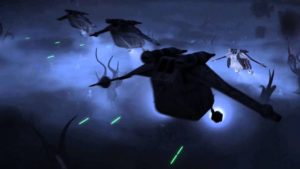 Heady questions that only science fiction can truly explore are all well and good but let’s not forget the actual title of the show: The Clone Wars. And the ‘wars’ featured in this arc are spectacular. The show has really come a long way since that theatrical movie which began the series in disappointing fashion, and the animated action in these episodes easily competes against anything seen in the live action movies. The camera work is incredibly dynamic, whether it be simply ground soldiers firing on each other in the jungle setting, huge insectoid tanks bursting from the ground and wiping out squads of clones, or the incredible space battle at the end of the third episode that is without a doubt the best of the series. All the action is punctuated by Kevin Kiner’s wonderful music; he truly is the show’s secret weapon and worthy of scoring a Star Wars movie one day. Before the Umbaran arc, the best battle scenes were in the second season episode ‘Landing at Point Rain’ but that has definitely been trumped and the story here is far superior.
Heady questions that only science fiction can truly explore are all well and good but let’s not forget the actual title of the show: The Clone Wars. And the ‘wars’ featured in this arc are spectacular. The show has really come a long way since that theatrical movie which began the series in disappointing fashion, and the animated action in these episodes easily competes against anything seen in the live action movies. The camera work is incredibly dynamic, whether it be simply ground soldiers firing on each other in the jungle setting, huge insectoid tanks bursting from the ground and wiping out squads of clones, or the incredible space battle at the end of the third episode that is without a doubt the best of the series. All the action is punctuated by Kevin Kiner’s wonderful music; he truly is the show’s secret weapon and worthy of scoring a Star Wars movie one day. Before the Umbaran arc, the best battle scenes were in the second season episode ‘Landing at Point Rain’ but that has definitely been trumped and the story here is far superior.
The four-part Umbara storyline might be the peak of The Clone Wars visually too. Umbara is a darkly beautiful world where the sun never rises. Most of the action of the first two episodes is set within the shadow of the jungle plant life and a thin mist, maybe natural, maybe birthed by battle, hangs beneath the foliage. It’s very dark, matching the tone of the story being told, and as alien and foreign a landscape that we’ve seen in the Star Wars galaxy. Natural neon colours of purple and red emanating from flora and fauna light the environments until blaster fire – green and blue bolts of energy – highlight previously unseen detail. It’s not the showiest visual spectacular the series will ever present but the visuals match the story so well and atmosphere pours from the screen.
The Umbaran technology also helps to present this world as truly alien. In a series filled with recognisable characters, planets and objects that since the original trilogy have passed into an almost modern-day mythology, and the fact that the show often reuses assets, it’s fantastic that this arc instead showcases unique technology to build the Umbaran people from the ground up. Their machines of war are unlike any seen before, from abstract ship designs with unusual but clear lines to huge centipede-inspired tanks that feel oddly biomechanical. The animation team put their full effort into this arc, even making Umbaran hologram technology something new and previously unseen, once again making it seem like our beloved clones are truly on foreign soil.
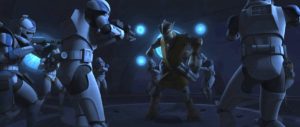 At the midpoint of the arc, you might be thinking that the clones may be teaching Krell a lesson and the point of the story was to show the Jedi come to understand and care for the clones on a journey not too dissimilar to that of the audience member. That, however, is very wrong. After ignoring Krell’s orders and instead following through on their own plans, Krell calls for Rex to execute the clones responsible, but in a tense scene the troopers fire wide and throw down their weapons. Seemingly before they can be disciplined, Krell sends them into the jungle to wipe out a counterattack of Umbarans who may be disguised as clone troopers from another garrison. Believing this to be the case, a firefight ensues before Rex removes the helmet of a trooper he’s felled and sees that he’s actually murdered a fellow clone.
At the midpoint of the arc, you might be thinking that the clones may be teaching Krell a lesson and the point of the story was to show the Jedi come to understand and care for the clones on a journey not too dissimilar to that of the audience member. That, however, is very wrong. After ignoring Krell’s orders and instead following through on their own plans, Krell calls for Rex to execute the clones responsible, but in a tense scene the troopers fire wide and throw down their weapons. Seemingly before they can be disciplined, Krell sends them into the jungle to wipe out a counterattack of Umbarans who may be disguised as clone troopers from another garrison. Believing this to be the case, a firefight ensues before Rex removes the helmet of a trooper he’s felled and sees that he’s actually murdered a fellow clone.
The following sequence of Rex running through the battle trying to get his men to stop firing as the music swells is one of the greatest of the series and it’s a truly epic and emotional moment when the clones realise that they’ve been butchering their own brothers. Together they decide to commit treason and march back to base to confront and arrest Krell, sparking a series of phenomenal action sequences that eventually leaves Krell imprisoned. However, when they discover that Krell planned to join Count Dooku, Rex decides the Jedi shouldn’t live, breaking his Republic and moral code, and goes to execute him in return. Upon lifting the blaster, he realises he can’t go that far, so Dogma – a clone previously the most loyal to Krell – kills the corrupt Jedi instead.
It’s a fantastic ending to the arc and the final episode is probably the best but I remember thinking the first time I watched it that Krell becoming so evil and openly acknowledging that he’s been working for the separatists was disappointing. Does it eliminate any subtlety and make his motives less interesting if he’s a straight-up villain rather than just a General who has no feeling for the clones he unnecessarily endangers? It does but I also feel there’s enough discussion about this subject before his villainous reveal that the concept is still amply explored, and we still have to remember that this is a kids’ show primarily so some simplicity of storytelling is to be expected. Upon rewatching the arc, knowing Krell’s twist, I enjoyed it much more and wasn’t blindsided by it. Instead, I think it unveils some more insight into the Jedi and clones.
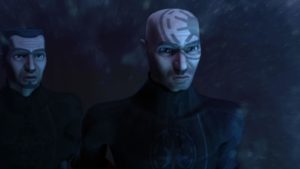 For the first three episodes we’re thinking that Krell is an extremist of the Jedi code and is taking the refusal of attachment way too far, ignoring the lives of the troopers under his command. While the arc still comments on this, Krell’s journey instead offers a counter to what the clones go through. The Jedi are, as Mace Windu says, “guardians of the peace not soldiers”, but due to this war orchestrated by Palpatine to weaken the Jedi, Krell has been corrupted by violence and has become amoral and cruel. The clones are the opposite and were bred for war and violence, their sole purpose, but instead over this arc become moral and thinking. And Krell’s defection at the end doesn’t change the ultimate consequences of the clones’ actions. Executing a defeated prisoner is still illegal and a war crime, and Dogma, despite killing an evil man (or Besalisk) is arrested at the end of the episode as Rex and his troops look on, clearly wounded and forever changed by their actions and experiences.
For the first three episodes we’re thinking that Krell is an extremist of the Jedi code and is taking the refusal of attachment way too far, ignoring the lives of the troopers under his command. While the arc still comments on this, Krell’s journey instead offers a counter to what the clones go through. The Jedi are, as Mace Windu says, “guardians of the peace not soldiers”, but due to this war orchestrated by Palpatine to weaken the Jedi, Krell has been corrupted by violence and has become amoral and cruel. The clones are the opposite and were bred for war and violence, their sole purpose, but instead over this arc become moral and thinking. And Krell’s defection at the end doesn’t change the ultimate consequences of the clones’ actions. Executing a defeated prisoner is still illegal and a war crime, and Dogma, despite killing an evil man (or Besalisk) is arrested at the end of the episode as Rex and his troops look on, clearly wounded and forever changed by their actions and experiences.
So, while arcs and episodes like ‘The Lawless’, ‘The Wrong Jedi’ or the more abstract Mortis storyline are often considered the height of storytelling in The Clone Wars, I feel that the almost standalone Umbara arc is the pinnacle of everything the animated series has been trying to accomplish. It radically changes your perceptions of both the clones and the Jedi in this conflict with some amazingly emotional and epic moments, as well as offering some of the best action and visuals in the series. It’s an arc I now plan to watch just as often as the live-action movies and, even if you’ve never seen an episode of the show before, the Umbara arc is an amazing story that deserves to be seen.
Have you seen the Umbara arc of The Clone Wars? What do you consider to be the peak of the animated series? Let me know in the comments and be sure to geek out with me about TV, movies and video-games on Twitter @kylebrrtt.




